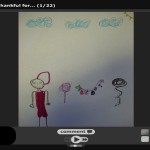Submitted by: Kendra Brown
School: Lakeside Elementary School
Summary
The purpose of this lesson is to instill an attitude of kindness and gratitude into the lives of our children. There are so many ways in which we can show acts of kindness and exhibit thankfulness, appreciation, and gratitude.
“Kindness is doing things for others, motivated by a true sense of concern and not merely a sense of duty or obligation. Kindness and appreciation make life a little better for us” (Wheeler & Stomfay-Stitz, 2005). In this world of crime and immoral behavior, good character is golden!
In this classroom guidance unit, students examine kindness, gratitude and diversity. They create a project that focuses on the things for which they were thankful. Students wanted to share their final project as a “Random Act of Kindness” with specific peers in mind. Our target audience consists of students with vision or hearing impairments, students with different learning styles and the community helpers who encourage us to be our best. By sharing with our community, family and friends we applaud the role models who continue to be an inspiration to our students.
TIPC Ratings
Developing – According to Lakeside’s most recent Counseling Needs Assessment, bullying & lack of respect ranked #1 in the areas of concern for parents & teachers. School should be a safe haven where our children can learn. As a result, we must implement a curriculum that embraces good character and kind deeds.
Studies show activities fostering kindness and gratitude are rapidly spreading throughout homes and schools in America. By simply using two jars and some beans, the lives of our students are forever being changed. To increase awareness levels, students are using one jar to place beans for each put-down, insult, or injury received; while the other is being used for “put-ups” or acts of kindness. Though very simplistic, Su Ellen Fried, founder of the Stop Violence Coalition believes it gives kids a visual image of what they are doing to each other. Naturally, the aim of this activity is to increase the put-ups and decrease the put-downs.
In another exercise a teacher provides a general overview of what kindness is and upon witnessing it, gives the student an object of recognition. The teacher then tells the student that they must now pass that object on when they too, have witnessed similar acts of kindness. Fried’s feedback indicated that “Children wanted to be observed performing acts of kindness.”
Approaching – In addition to scheduling COWS with our Media Specialist, time was scheduled with the ITRT to discuss technology needs, protocol and procedures. Teacher communication was necessary to access student folders, set-up Voice Thread accounts, and to communicate the final projects to parents (grade level newsletters). Parents were also informed via ConnectEd that they could view the counseling website. Lastly, a tips sheet went home highlighting ways in which we can teach thankfulness. E-mail and the world wide web also served as a platform to communicate our lesson. Once in Voice Thread, family, friends and community were provided the opportunity to provide electronic dialogue/feedback. Students are then able to respond to comments received from other schools, family members, school faculty/staff, etc.
Ideal/Target – The ActivInspire (Flipchart) activity on Making Applesauce was based off of a prior knowledge and designed to create authentic connections for the students. It specifically addresses the concept of following directions, reading a recipe, measurements and sequencing. Students were also encouraged to consider the consequences of negligence. Students utilized problem-solving skills to address what would happen if they were to use a knife or attempt to cook the apples on a stove.
Ideal/Target – After determining the concept of this lesson, I researched programs that would aid in the delivery of our message. Voice Thread was great with the exception of the speaker’s photograph being displayed. A self-portrait using Pixie was an ideal response to accommodate the increasing number of students who could not be photographed. In addition, students felt the input verbiage would allow them to communicate their Voice Thread to a larger audience regardless of time zone or physical distances.
Note: For security purposes, communication from outside sources had to be approved by teachers before being seen live.
In lesson 3, students had the flexibility of selecting their recording/word processing method when presenting group rituals.
Examples of the giving and gratitude Wordle was enjoyed by all.
Student Artifact
Download Files
- Apple Producing Flipchart
- Graphic Organizers
- The Giving Tree Lesson Plan
- Student Samples





